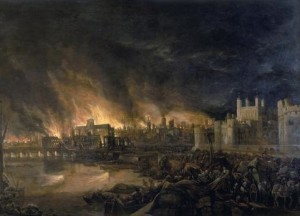In 1681 William Penn was “extraordinarily busy” on behalf of his new colony, but he was not yet ready to leave England. He needed someone to deal with the land in his place, so he appointed commissioners. They had to select a site for the town, negotiate with the Indians and buy the land, begin to sell and lay out land to the purchasers. It was a big responsibility and he chose men he trusted, seasoned older men with experience—his cousin William Crispin, Nathaniel Allen, John Bezer, and William Haige. They prepared to sail to Pennsylvania and assume their new job. 1
“His Philadelphia was to be a city such as the world had never seen (and never would see).” 2
Penn had a vision for his town. It would be as unlike London as possible. A line of country houses, each one on its spacious plot, surrounded by orchards and fields, set well back from river — this was his idea, “a green country town which will never be burnt and always be wholesome.” Any Londoner Penn’s age would remember the plague of 1665 and the Great Fire of 1666. His spacious green city would not suffer such a fate. 3
He had promised the First Purchasers that they would get a bonus lot in the city, one acre for every fifty acres purchased. To keep his promise if all 500,000 acres were sold, he would need 10,000 acres. He sent the commissioners with detailed instructions for picking out a suitable tract. It was to be in a place where the Delaware was navigable, and the bank “high, dry and healthy”. Marshy places would breed disease and offer poor moorage for ships. Ships should be able to load and unload at the river bank, and there should be a creek for smaller boats to unload. Preferably it would be open land, not taken up and settled already, but if the most convenient place was already taken up, the commissioners were to persuade the owners to trade some waterside land for land further back. This was the charge Penn gave the commissioners as he sent them on their way in the fall of 1681. 4
As it turned out, being one of Penn’s commissioners was not a healthy thing. William Crispin never reached Pennsylvania and died on the way. To replace him, Penn turned to Thomas Holme, an Englishman who had fought in Cromwell’s army when it subdued Ireland. Holme stayed on after the campaign ended in 1653 and became a Quaker. As a soldier he worked as an engineer and a surveyor. As a Quaker he spent time in Dublin prison with Quaker merchants like Samuel Claridge and Robert Turner. Penn made Holme his Surveyor General, with broad responsibility. Holme sailed in the summer of 1682 on the Amity with his children and servants, ready to join the other three commissioners and to lay out the province. 5
When the commissioners arrived and looked for sites for the town, they did not find virgin land on the river. The land on the Delaware had been settled for almost fifty years by a mix of Swedes and Finns, part of a little colony sent out from Sweden in the 1630s. There were only a few hundred of them when the Quakers arrived, but their lands were spread out along the Delaware and Schuylkill Rivers, leaving no large tract unsettled between New Castle and the falls of the Delaware near later-day Trenton. To get a large tract on the Delaware the commissioners would have to bargain with landowners. Looking for the best option, the commissioners chose a site owned by Swan Swanson and his sons, on the Delaware north of Upland. It was well provided with small streams, heavily wooded and had a high bank. In addition it had a cove where small boats could be moored. To buy out the Swansons the commissioners offered twice as much land up the Schuylkill. This would give Penn 300 acres for his city, with a fine high bank along the Delaware. Another purchase, from Peter Cock and Peter Rambo, extended the tract to 1200 acres. Why didn’t the commissioners buy more land? The answer was probably in Penn’s instructions to them, where he urged them to “Be as sparing as ever you can.” Penn did not want to spend more than he needed to, and buying 10,000 acres on the Delaware would have meant buying out many more owners. 6
Because the tract was smaller than the 10,000 that Penn originally planned, he could not give the First Purchasers the bonus lots he had promised them. The solution to this problem was to give the bonus land in two pieces — a city lot and a larger tract north and west of the city, in what is now the Northern Liberties. There is no record of what the First Purchasers thought of this compromise, but their actions spoke for them. Many of them sold their rights in the Liberties to others, keeping the valuable city lots instead.
With the site chosen and the promise of bonus land kept, the plan of the city was set, and the way was clear for people to claim their lots, build houses and wharves and warehouses, and begin the process of making Penn’s green town into a bustling center of trade and commerce.
- Jean Soderlund, William Penn and the Founding of Pennsylvania, p. 82. ↩
- Richard Ryerson, “William Penn’s Commissioners”, PA Genealogical Magazine, 1981-82, vol. 32. ↩
- Soderlund, p. 85. The image is from the Wikipedia entry for the Great Fire. The painting is by an unknown artist. ↩
- Soderlund, pp. 83-85. ↩
- Silvio Bedini, Thomas Holme (1624-1695) Pennsylvania’s First Surveyor-General ↩
- Hannah Benner Roach, “The Planting of Philadelphia part 1”, PA Magazine of History & Biography, 1968, volume 92, pp. 13-15, 23. Soderlund, p. 204. ↩

